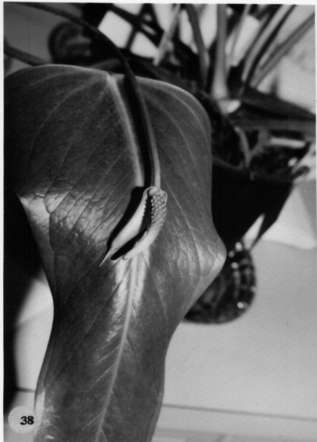



Anthurium chamulense Matuda,
Anales Insl. Biol. Univ. Nac. Mexico 27: 339. Fig. 2. 1957.
Anthurium chamulense ssp. chamulense.
TYPE:Mexico. Chiapas: San Juan Chamula (just NW of San Cristobal
de Las Casas) MacDougall 348 (MEXU, holotype—not found).
Anthurium motozintlense Matuda, Anales Insl. Biol. Univ. Nac. Mexico 43, Ser. Bot. (I): 55. Fig. 4. 1972(Publ. 1974). TYPE: Mexico. Chiapas: Sierra Madre, El Rosario, Motozintia, 1,800 m elev. MacDougall 393A (MEXU, holotype).
Anthurium monserratense Matuda, Anales Inst. Biol. Univ. Nac. Mexico 27: 342. Fig. 3. 1957. TYPE:Mexico. Chiapas: Municipio of Cintalapa, near Finca Monserrate, alt. 1,000 m. MacDougall 285 (MEXU, not seen).
Epiphyte or on rocks; roots tan (dry), ca. 2 mm diam.;cataphylls subcoriaceous, 3.5-10 cm long, rounded at apex (subapical apiculum ca. 2 mm long), drying medium to dark brown (B & K Yellow-red 4/10), persisting as reticulate fibers.
LEAVES usually erect; petioles D-shaped, 14-32(47) cm long, 2-6 mm diam., sharply and broadly sulcate; geniculum 1.5-2 cm long; blades coriaceous, narrowly to broadly triangular, 13-37 cm long, 5-26.5 cm wide, broadest 1-2 cm above base, acute to narrowly rounded and apiculate at apex (the apiculum 1-2 mm long), truncate to obtuse or broadly lobed at base; anterior lobe 13.5-30 cm long; posterior lobes 3.2-12 cm long; sinus arcuate to arcuate with decurrent petiole, rounded at apex; upper surface semiglossy, the lower surface matte to semiglossy; midrib bluntly raised at base, diminished and sunken at apex above, raised at base, flat at apex below; basal veins 3-5, the uppermost free (sometimes all free), third or fourth coalesced to 3.5 cm; posterior rib naked, turned up; primary lateral veins 7-19 per side, departing midrib at 45° angle, sunken but scarcely more conspicuous than lesser veins above, prominulous and darker than surface below; submarginal collective vein arising from first or second basal veins; third basal vein loop-connected to collective vein, 2-15 mm from margin.
INFLORESCENCES erect to spreading, shorter than or as long as the leaves; peduncle 27-48 cm long, 3 mm diam.; spathe moderately thin, pale green tinged pink at base and apex, ovate to ovate-lanceolate, 3.5-14 cm long, 1.3-6 cm wide, broadest just above base, abruptly to gradually acuminate at apex, rounded to truncate at base, inserted at 10° angle on peduncle, the area around stipe thickened, donut-shaped; stipe 3 mm long in front, 1.5 mm long in back, green; spadix green becoming slightly to heavily tinged with violet-purple (B & K Red-purple 2/5), 3-13 cm long, 5.5-10 mm diam. at base, 3-6 mm at apex; the flowers rhombic, 2.2-2.3 mm long, 2.4-2.5 mm wide, the sides straight to broadly sigmoid; 5-6 flowers visible in the principal spiral, ca. 5 flowers visible in the alternate spiral; tepals matte, sparsely punctate, minutely papillate, lateral tepals 1.6 mm wide, the inner margins broadly rounded; pistil emergent, bright green; stigma a nearly obscure slit; stamens emerging in a prompt and complete sequence beginning at base, sometimes with as many as 3 emerging simultaneously, the leading stamens no more than 3 spirals ahead of completed sequence; anthers cream-colored, held in a tight cluster obscuring pistil, 0.8 mm long, 0.9 mm wide, shrinking to 0.4 mm wide; thecae ovate, slightly divaricate; pollen white.
INFRUCTESCENCE pendent, 7-10 cm long, 1.5 cm diam.; spathe persistent, berries red, obovate to round; seeds not seen. Fig. 38.
The species is known only from southern Mexico in Oaxaca and Chiapas and consists of two subspecies. Subspecies oaxacanum Croat is known only from the type locality in northwest Oaxaca in "selva alia perennifolia," while subspecies chamulenseis widespread in Chiapas and is expected also in Guatemala. It ranges from 1,500 to 3,000 m and is perhaps restricted to regions of "bosque pino-encino." Most collections have been made from northern Chiapas but the species has also been collected in the Municipio of Motozintia in southeast Chiapas and also in the Municipio Villa Corzo in south central Chiapas. One of the collections from the latter collecting area (MacDougall 376) is somewhat aberrant in that it has a thicker blade with more conspicuous posterior lobes. This specimen perhaps represents a distinct species but it is too incomplete to be certain. Anthurium chamulense is tentatively placed in section Belolonchium and is distinguished by its coriaceous, ovate-triangular leaf blade usually with short lobes and broad sinus (when flattened). Live plants (especially those populations seen at Pueblo Nuevo Solistahuacan) exhibit a characteristic vein pattern with the tertiary veins scarcely visible on the lower surface but clearly visible and minutely etched on the upper surface.
 |
Mexico Chiapas: 1980 m,, 21 Oct. 1988, Breedlove 70502 (CAS).
Mexico Chiapas:, 7 Mar. 1952, McDougal 285 (MEXU).